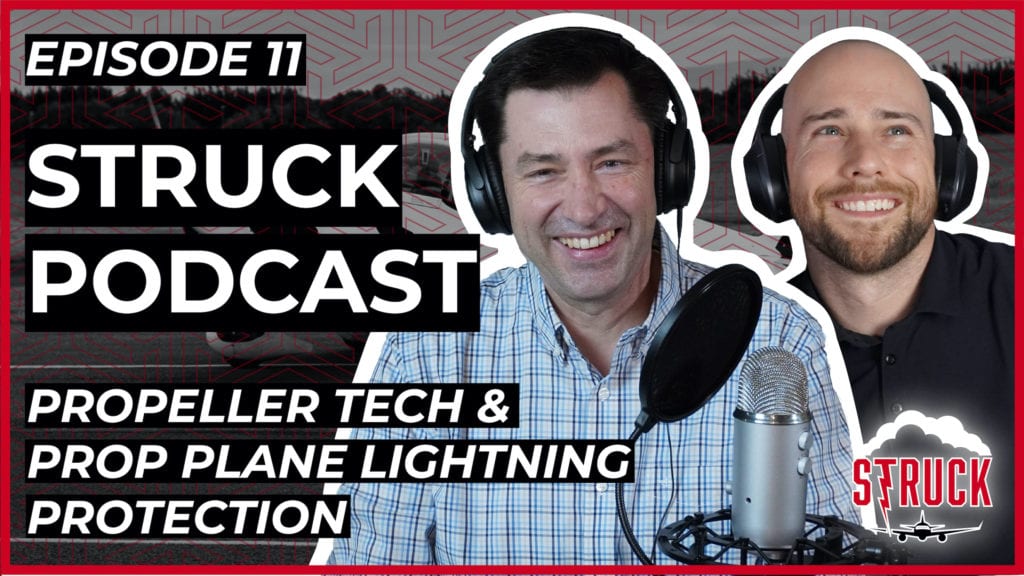In Struck episode 11 we discussed propeller planes and what happens when lightning strikes. Propellers used to be made of wood, then aluminum and now carbon fiber, but leading edge erosion and protection is critical, so how do manufacturers plan for this?
Learn more about Weather Guard StrikeTape segmented lightning diverter strips. Follow the show on YouTube, Twitter, Linkedin and visit us on the web. Have a question we can answer on the show? Email us!
Watch the YouTube video version here.
Podcast: Play in new window | Download
Struck Podcast EP11 Transcript: Propeller Technology and Prop Plane Lightning Protection
Dan: This episode is brought to you by Weather Guard Lightning Tech. At Weather Guard, we support design engineers and make lightning protection easy.
You’re listening to the Struck Podcast. I’m Dan Blewett.
Allen: I’m Allen hall
Dan: and here on Sruck we talk about everything aviation, aerospace, engineering, and lightning protection.
Allen, how are you doing? Episode 11 we’re really getting up there.
Allen: Yeah. Exciting.
Dan: We’re 10% deep. 10% more than we had last week.
Allen: Oh, that’s true.
Yeah. That’s good. Good math right there.
It’s ready to go for a philosophy
major, right?
Dan: Yeah. Gonna be going to continue getting, getting lower and lower as we go.
Well. Oh, that’s true too. Right? It’s a declining return on investment.
Right. So, yeah, this is rough. This is rough. So today’s episode we’re going to chat about, um, leading edges on, uh, on prop planes, uh, and some of just the electrical problems that can cause like noise issues and obviously like the lightening implications.
Yeah. Um, cause there’s obviously a lot of different types of props. There’s different ways of combating that stuff. So that’s kind of on our docket today. That’s gonna probably. Be a pretty widespread conversation it sounds like. But first things first, what’s your favorite airline? Oh, you have to pick one.
Who do you go with?
Allen: American and in America
Dan: In America.
Allen: Southwest.
Dan: Southwest.
Allen: It isn’t because I like them either. Uh, because I, I really. The thing about Southwest is so, well, it was so full. Every year, every flight I’ve been on with Southwest, and probably the last two or three years has been 100% full. Uh, but you got to give them some CRA, a little bit of credit that the.
Flight staff is very amenable, helpful, upfront, cheery, and you do get on off the airplane pretty fast and they fly a lot of different places and it’s pretty clean cut. So you can put some luggage on the airplane and they get charged a whole bunch of money. Yeah. Southwest,
Dan: Southwest, I do like their baggage system.
I’ll give them that. I had a couple of rough experiences, uh, like the last, within the last two years kind of soured me on it. But I do agree with everything you just said. It’s nice when you’re on like Delta or American, they’ll have power outlets on the seats that someone doesn’t have yet.
But Southwest has the free, and I don’t know if other airlines do this.
Maybe Delta does, but uh, Southwest has the free live TV and movies that are free and you can, you can buy wifi for about eight bucks, whatever it is. So that’s, that’s not bad. Yeah. It’s
not bad.
No, it’s not bad. It’s just so full. Where Elisa was, it was so full. It’s not full anymore.
No more. Yeah. In the land of coronavirus, that was the before time in the before time.
They had full airplanes. Right after time. Well, I’m not so sure.
Allen: What do you think it’s going to change? I don’t think it’s gonna change all that much.
Dan: I think probably I probably can’t. The logistics there just won’t make sense to fly half full airplanes.
Allen: No. No, it makes zero sense at all. And I’m kind kinda wondering, based on some of the Twitter traffic I see lately airplanes are pretty fall in some cases.
Uh, you know, you’ve seen some of the passengers complain about the flight being 100% fall and the airlines trying to respond to that. What are you going to do? What are you going to do? I don’t know. You go on to do something, whatever that answer is, I don’t know. Make everybody wear a mask. I’m sure that’s what the, the answer is right now, and then try to spray the airplane down with Lysol or whatever they’re doing between flights.
That’s what else can you do?
Dan: Yeah, yeah. I saw a report, which I’m over the whole, you know, they just report these crazy cases. If like, you know, Oh, here’s a young person that that died from coronavirus. They’re like the one young person in the country or whatever, and it’s like, let’s not all freak out over.
Like there are people with all sorts of afflictions that afflict a tiny percentage of the population. It’s unfortunate, but I’m one of them. So there was a story about this, I guess he is, this guy was a virologist. That’s just like he’s a doctor and he was on a flight and he had a mask. He had his gloves like he was fully suited up.
Got it, got covert from it, and he was like, Oh, I probably got through my eyes. Then. And there was like, Oh God, it’s covered through the eyeballs.
Allen: We need goggles.
Dan: Um, and it’s like, I mean, I guess that’s seems legit. Like if you, if I, you know, if you cough in my eye right now, yeah, I’ll probably go like, you can run a virus from it.
Totally get it. Like that’s how you become a zombie in the movie. I’m 26 later. The guy look it up and he gets a drop of blood in his eye and he starts freaking out. He’s over.
Allen: Right?
Dan: So I don’t know that they, I don’t think that story got too much traction, but for a minute everyone’s like, Oh man, it’s over.
It’s over. Right.
Allen: It’s, it’s, it’s the, Bob didn’t listen to instructions. Now Bob has Corona and yeah.
Dan: Okay, sure. You might goggles, but right. Yeah, it’s going to be interesting. There’s so, I don’t know, this is just like such an ongoing saga, trying to keep everyone healthy, like, and it’s legitimate, like we all want to try our best.
Obviously it’s a real thing, but it’s just like only so much you can do at some point.
Allen: Right. And I think you have to just be smart. I think a lot of it is just being smart. It’s just like the whole thing at the masks in the last. 72 hours or so, where before it wasn’t, it wasn’t like yesterday where the CDC came out and said, Hey, masks may be helpful.
Yeah, no kidding, right. God, I know captain obvious pops up my head when I hear stuff like that, but. Again, it’s most, most people would have had that thought already and said, Oh, you know, why don’t I put on a mask? Because it probably makes a little bit of sense for me to do that here. Okay, I’ve got to go throw another commercial to home Depot.
But when I was up at home Depot the other day, everybody had a mask on, and it wasn’t because it was Forrest, it was because, uh, everybody was thinking about everybody else still, which is, which is
Dan: good. Yeah. Yeah, I mean, speaking of that, Costco, we got a lot of press this week because a Costco employee, uh, took away someone’s cart that wasn’t wearing a mask, and it was like an irate customer was like, Hey.
This is a free country. I’m not wearing a mask. And the guy’s like, no, it’s our store policy. Like you can wear a mask or you know, like go home. And the guy’s like trying to shame him. And the guy just was still polite and just like, sorry, like you’re not welcome here anymore. Took his cart. Was that a Washington
Allen: DC?
Like the lady in the Walmart. No,
Dan: no, I don’t think so. We’re doing all right. But, um, it’s like, yeah, I mean, like, that’s never not been a thing. Like, uh, you know, businesses can say you have to wear a shirt, you have to wear shoes. They’re allowed to do that. It’s a private business.
Allen: You can’t bring in your pet into the store or, right.
Unless it’s, you know, you have a medical reason to have the pet in the store and then fine. Right?
Dan: Yeah. Come on.
Allen: So
Dan: yeah, it’s like this strange, like I, it’s America. I want to do what I want. It’s like, look, just go grocery shopping in a mask. It’s not a big deal. Just really not that big a deal and just go about your business.
So
Allen: I can, I can drive on the wrong side of the road too, but I don’t do it because I’m going to hurt somebody. That’s why I don’t do it. Right. Yeah. You can do a lot of things that, that are not smart. That’s just not smart right now. Just be kind, just be kind. Right.
Dan: It seems like the way to go. So let’s talk about, uh, prop lands.
So back in the day when planes were made out of, they had wood propellers. What would happen if they got struck by lightning? Just to, yeah. See, I think
Allen: it’s over. Goodbye. Right. You’re, you’re now a glider, a very heavy glider.
Dan: It’s not ideal. No. Where there were there any that you know of, documented, like planes that went down like that, like their propeller gets hit, splinters, shatters, and just.
Allen: Nothing comes to mind at the
Dan: minute, but I didn’t think of in my research either.
Allen: Well, if you ever go down to the air and space museum, which is what, five blocks from your, your
Dan: sticks, it’s a, it’s probably a mile and a half. No,
Allen: it’s walkable.
Dan: Yeah, for sure. Everything’s walkable in DC.
Allen: Yeah. So at the air and space museum back in 2003 right.
So it was the hundredth anniversary of the. First Wright brothers flight, they had a big display, and I don’t share that if that display is still up or not, but we, we took, we took a Southwest airlines flight to DC for the day to go to see that exhibit. And one of the things that they had there were some of the original propellers, uh, for the Wright flyer.
A, he just went, you thought just off, my God, how does somebody come up with that and how did that not come apart? I don’t even know. You know, it’s, it’s a, it’s a miracle that they made that work and they have put enough engineering into it to get it to work. But one of the, one of the things you see in a lot of propellers, even back then, I mean, we’re talking 19 well, 1908 1912 is that they started to put some metal around the leading edge eldest propellers and make it more durable.
There you go. Right. And then a lot of, well this, this, and especially when you got into world war one, you see that a lot more well, world one where you see metal on the leading edge of propellers, just make it more durable.
Dan: Yeah. I’ll speak. Speaking of interesting propeller stories, I went into the, uh, I think it was the world war one museum in Kansas city.
Have you been there?
Allen: No,
I
Dan: haven’t been there. I think it’s the world war one museum. And uh, I really liked it. I learned a lot. I didn’t know much about world war one because. We just never studied it in school. And although I like, I like history, I’m not like a crazy history buff, but I had no idea how crazy that war was, was just like, Austria did this and then Germany punched them in the face and then they punched, it was like this crazy thing.
I mean, it’s a, it’s a really fascinating thing. Again, like didn’t learn that in school. So, you know, then you get to college and you study what you study. So it just like got overlooked in my education. But anyways, I thought was really fascinating. But one of the tour guides was a, so when we were into the area where like.
Talking about a lot of the presidents, and they had a cane, this wooden cane, and I just happened to be standing there like we weren’t on a guided tour, but one of the tour guides was explaining that this cane was from Teddy Roosevelt’s son who was shot down. Um, you know, he crashed and died and a soldier found, found the wreckage, took the wooden propeller, widdled it into a, into a cane and gave it to him.
Uh, president Roosevelt, this was, this was, this was, and I watched the Roosevelt, uh, documentary recently, and this was like his, his youngest son, like the really like gregarious. Like everyone loved him. They said it was like Teddy Roosevelt’s favorite son, even though I know fathers, you know, try not to like, say that, but, um, and yeah, they said he, he used that, that walking stick or that cane until, until, until he passed on.
So it’s really interesting story. Yeah.
Allen: Yeah. I didn’t know that. I know next to us, uh, not very far from us. Maybe an hour and a half or two hours from here as the Rhinebeck or old Rhinebeck arrow Drome where they fly world war one vintage aircraft on the weekends. It’s fascinating to watch her over there last summer, watching them fly those world war one airplanes, uh, one they’re really, really noisy and there are just so rudimentary.
Simplistic things. You got to wonder how many pilots died because the airplane broke. Probably most of them. Uh, when you see those airplane fly because you don’t have that experience at one about the size of them, you don’t get a perspective on that. And then you get up close to me, like, man, this is all made out of wood.
And it’s not like they’re, they got castor oil on the fuel so that that can lubricate the motor and someone who have the rotating motor bit and they have these weird spark plug firing mechanisms to change the speed of the motor. And just really, you know, you’re, you’re 15 ish years away from the. Right.
Brother’s flying to sort of world war one share airplane things. That’s, and, and the, the, when we were over there, one of the interesting thing was, is all the propeller technology, how much propellors had changed and those 10 to 15 years from the Wright brothers to where they were in world war one, there was some pretty good.
Unique advancements, but a lot of those propellers are, I think they’re all made out of, uh, out of woods still. They really hadn’t switched over because it had been too heavy to make out anything. Metallic
Dan: wasn’t. So what about elephant tusks? They were like so many elephants back then. I’m like, come on guys.
Allen: There’s so many things you could have built it out, but I think they had. Well, it’s just like today with us and aluminum. We know so much about it. We don’t want to change it because we’ve developed a whole industry around it. And at that time, they had developed an industry of making airplanes out of wood.
So, uh, that was something that they knew cause they had made wagons and things like that, or wood and homes and things out of wood forever. So to take the knowledge base they had and to grow it into airplanes, this is what they did, even though they had, uh, one of the interesting things does, he had a, uh, a, uh, replica of the spirit of st Louis.
That they have built so you can get really close to a replica of the spirit of st Louis. And even then, that was 1927 roughly. Wow. That’s would pretty much all of it’s wood. Uh, you know, there’s, so you look at the, some of the structure in there, at least I thought it was, I had to go back and look at that, but it was just like the most flimsy structure you could imagine to be flying in across the ocean.
But there is no way I would do that.
Dan: Yeah. So then where do we go after wood? Was it aluminum? Like what was the next like commonly? Yeah, use, that was aluminum.
Allen: It happened during world war II. Uh, that’s like the bomber. Some parts of that are made out of wood and fabric, but a large part is made out of aluminum.
And then, um. No. Then we started getting to sort of aluminum propellers and because of the props guys, props got so big that you couldn’t make it out of wood anymore. So it was around just before world war II. Yeah. And then that was the beat
Dan: was the beat 29 the one that they were just talking about and that, that checklist book that we, we both recently read.
Did you get? Did you get to that part in it yet? I’m pretty sure it was the B 29
Allen: I don’t think I got to that part yet. Like I said, that book is enormous. I don’t know why that’s a world’s longest audio
Dan: book. Why do I not think it’s enormous? I don’t know. So we referenced this in our other podcasts, but this book called the checklist manifesto by a tool Gawande, who is a physician who’s just advocating for the use of checklists in highly complex jobs like medicine, construction, you know, aviation.
But he talked about when Boeing. Was about to unveil I, I’m very sure it became the be 29 they had this new plane that could hold like, I guess the, the department of defense said we need a bomber that can hold X amount of bombs. And then Boeing is like, Hey, we got one that’s got like five times more than that.
Like way more. And then, so they basically were about to roll this out. The test flight was basically just like a, like we already know, like the defense part of defense knows that they’re going to buy this plane. Like this is like the one, and then. Because it could do so many new things. It crashed and then like the deal was off and they gave this big contract to like a lesser bomber.
I can’t remember what though the rival company was and then direct, but basically they said like they had this test pilot who was very, like, it was like one of the best test pilots out there at the time, but he just like, it was just a complex plan. He like forgot something and the thing went down and I think years later they’re like.
People were afraid to fly with like Wolf, the best guy crashed this like this planes on flyable. It’s too, it’s too complicated. And then they just started devising checklists and all these systems to just like, and then they’re like, this plane is great. And then it eventually became what it was supposed to be, which, like I said, I’m 99.9% sure that this was the the be 29 yeah, I think, yeah, so I understand the story.
Allen: It was an interesting story because I think they found that they had some control locks. Very simple things to keep the surfaces, the control surfaces from blowing around in the breeze when it gets windy and, and breaking something. So they have these controls, if I remember correctly, at some control locks and things that now we now put red flags on, so you can’t miss them.
Uh, so you make sure you remove them before flight. They actually save, remove before flight on, on these little flags. Uh, I think that was the act. That’s what drove that accident. Yeah, that’s right. Yeah.
Dan: Yeah. So, well, you’ll get there at some point in the book, which is apparently the longest book of all time, but it felt not that long to me, but maybe that’s just because I haven’t, I haven’t had that many good audiobooks on my list recently.
Allen: The war piece of audio books, I don’t know why.
Dan: I got to figure out how this as is. What is, let’s go to the source.
Allen: How many chapters can you put in an audio book? Because there’s no way that paper version of that was that long. Unless they’re like the world’s shortest chapters, but when he read it out, it’s different.
Right? So when you scan it with
Dan: six hours, 10 minutes, that’s a short audio. Okay,
Allen: wait, wait, wait, wait. How many chapters are there? Because I graded in chapters, there’s probably 60
Dan: what do you in middle school, you grade it by chapters. There’s a chapter book. You got five pages pages.
Allen: Uh, and there are no pages.
The only way in the podcast world, the only way to know how far, how long this thing is, is to scan through how many chapters they have. There’s no way there was that many chapters in the real book. Nope. There’s no way.
Dan: I don’t know. I can’t, I can’t jump to it that quickly, but yeah, not, not a long book because six, six hours is maybe 160 pages, something like that.
No, come on. Yeah, yeah, sure. Well, my book is 300. 320 pages maybe, and it’s about 12 hours long.
Allen: No. Okay. Alright. Yeah, I’ll, I’ll, I will yield to you eBooks. I’ll take airplanes. You have eBooks
Dan: while most of your books, most eBooks are eight to 10 hours. That’s, that’s typical. Man, I don’t want to see, and that’s like 200 to 250 pages.
That seems like,
Allen: well, you know what the thing is, I’ve done a lot less driving. Um, usually I listen to eBooks when I drive. So it’s easy and you don’t think about the time going by because you know, you’re going to spend an hour in a car regardless. Uh, and with our son being home from school, we’re not going back and forth to where he goes to school at, which is about.
You know, little over an hour, hour, 15 minutes. And so I used to listen to the eBooks when I don’t do that anymore. So now it seems like those eBooks last forever.
Dan: Yeah. I just, uh, I just go in cycles. We’re all listened to like an absurd amount of ’em cause I do have a lot of just like time where I’m doing kind of busy work or whatever, or I’m walking or doing something.
Um, but I just like, I’ll, I’ll read like 30 eBooks in like four months and, or audio books in four months and they’ll just be like out of them for a while. Like I just can’t find one that I want to read or whatever. So I kind of go, like, I kind of have ebbs and flows. So in my year, so I’ve been on a lot of podcasts recently,
Allen: but I only read eBooks that you send me.
So that’s what I’m doing. Whatever Dan sends me is what I’m
Dan: reading. There you go. But that one was good. I mean if you’re out there listening, highly recommend this book, the checklist manifesto. Cause especially if you’re in. This industry. It’ll give you some perspective for like me, for like making websites even for like these shows, like getting a podcast going.
You can easily forget one thing and it screws you up. Like, you know, you get the wrong frame rate on your camera, you forget to hit play. Which I’ve had numerous podcasts and done that numerous times, and you’re like, you got to have a checklist. Just run through. Is the light green? Is that light green? Is this running is, you know, like is the male side, is my computer plugged in?
Is my camera have battery? Like all that stuff, because super easy to figure out one of the six things. Then it shuts off halfway through and you’re like, Ooh. So there we are. Alright, so back to propellers. Um, so aluminum, how do they handle lightning strikes?
Allen: Aluminum is great because it’s really conductive and it just goes into the engine.
It causes a lot of problems in the engine. But propellers just get these little burn marks on the edgy. A lot of times you just buff them out. Um,
Dan: they wouldn’t, I mean like how sharp are they at the end? I mean, obviously they’re like pretty big and thick, so they’re not too thin where they’d melt at the end, just like a little burn.
Allen: Yeah, it’s, it’s like someone took a welder and hit the end of it. Electric welder. That’s
Dan: what it looks like. A little burn Mark.
Allen: Gotcha. Yeah. Yep. Maybe because it’s spinning so fast and the. It’s sort of hit. Lightning tends to move to all the different blades. So it kind of divides out the energy to each of the blades.
Dan: Oh, that makes sense. Yeah.
Allen: Yeah. So it’s kind of like on, off, on, off, on, off thing. It happens. Yeah.
Dan: Okay. So then it gets routed through the engine. What happens then? Cause that seems like a disaster. He was like, the worst thing that can happen is a light. Lightning strikes your engine, but they don’t, they’re not going down like, you know, like,
Allen: Oh no, no, no, no, no, no, no, no, no.
It’s not a crash situation. It’s just that all the bearings and all the raceways that are. Oh, there’s very expensive surfaces that have been machined into the finitude. The motor housing get ruined, and so you have to go in and tear the whole engine apart and it’s expensive. So pilots hate it. Absolutely hate it.
That’s why you don’t fly around lightning because that, that repair or inspection is so costly. It’s crazy expensive. So the,
Dan: and the, and turboprop planes are mostly smaller planes these days. I think I’ve only blown them, maybe one in my life. I took a flight from. I think it was, I think it was Vancouver to Edmonton.
We took a prop plane and so I had to walk out on the tarmac. It was like, what is, what am I going through a time. Mind the Twilight zone right now, like what’s happening. It was really strange. Was really cool.
Allen: Olsen music in the background. Yeah, yeah,
Dan: exactly. Yeah. Suddenly I looked down, I’m carrying a briefcase, my laptops, a writing tablet.
Allen: It’s like Casa Blanco. Yeah. It’s just like that.
Dan: Cool. It was cool. It wasn’t a very big plane and maybe like 60 seats or something.
Allen: Well, this is a thing about weight and balance. It’s the only the time. Well, there’s two airplanes I’ve been waiting balanced on w w mostly on, uh. Propeller driven airplanes, but I got weight and balance on an Embraer one 45 one day.
That was interesting, but
Dan: moved to the other side or what happened.
Allen: Yeah. I had to move forward of all things. I had a nice, like a whole roll in the back by myself. Like, I sir, we need you to sit up here in the crowded space. Dang it. But, uh, yeah, I used to fly a lot of propeller airplanes. Um. Yeah. American airlines used to have a bunch of them in the Midwest, and so they were, they were shorts, uh, airplanes, which is a high wing, very similar to the sky.
Courier that Sustenna is developing right now, a very similar airplane that was kind of a boxy thing, uh, with high wing that the, that the bell has made in Belfast, and that used to fly in that quite a, quite a number of times in college. And then obviously I’ve flown in enough kingdoms in my lifetime just from, from working there.
So I’ve been a lot of propeller airplanes. It’s, they’re interesting. They’re kind of, you know, that the thing is that they’re a little noisy. But there’s reliables I’ll get out those turbo prop engines. The PT six engines are so reliable. The safety records, just off the charts.
Dan: And when we say turbo prop, what, what makes it a turbo?
Allen: Uh, air? It’s
Dan: just air injected. Like, like a turbo, like parked car engine or what
Allen: sort of, it’s essentially a jet engine with a propeller on the end of it. Think of it that way, right? It has a hot section in it and there’s a propeller. So. It’s very similar to, it’s essentially what it is. It’s a jet engine with a propeller on it.
Dan: and what’s the advantage of that?
Allen: Uh, it’s not a piston, so it’s got it, it’s not a piston engine, so it’s got a rotating core, much like a jet engine. So the
Dan: jet engine is rotating and the propeller yeah, essentially, yeah.
Allen: Yeah. There’s sometimes a gearbox, there’s usually like your box or something in the middle of there, but yeah.
Uh. It’s a very efficient way to burn fuel and rotate a Repeller, and it’s such a simplistic mechanical device, and they’ve done it for so many years that their liability just shot way up because they’ve just made them better and better and better. Yeah.
Dan: So you say they don’t want to get hit by lightning, so avoiding flying in storms one thing, but is there anything else they do to the turbo prop plane or prop plane in general that.
Can say, Hey, strike me here. Don’t strike me on the propeller.
Allen: No. Cause the propellers shouldn’t be so large. Rest to the, to the. To the aircraft itself, they tend to be high, the highest thing and the lowest, or almost the lowest thing. Uh, definitely the highest thing on it. And the just cause of where they are, they tend to take most of the strikes.
So it’s, it’s really hard. Like on the King airs, the 19 hundreds, uh, the Q 400, those Q 400 has a longer nose on it, but a lot of times the engines just get struck. And with the, the latest propellors being made out of carbon fiber. Or some sort of caviar, a non-conductive stuff. The propellers have changed quite a bit over time.
I know when I was working at beach there, they were using, uh, uh, composite propellors and, uh, very so much we’ve been talking about our wind turbines. They. They had, um, essentially a nickel hard, metallic leading edge to, for prevent erosion of the blade and knit and ice particles and that sort of thing.
And one of the things on the static side was that those propeller blades would charge up. And then he just starts throwing this huge electrical sparks everywhere. It would make the radios all staticky. The pilots couldn’t use the radios and it would throw this, these big RX to the side of the fuselage.
And. It was exciting. Uh, but you know the, the thing about those composite propellers is it is so dang reliable. They don’t crack a problem with anything out of metal, is that you’re looking for cracks to develop. It cracks, it don’t stop. And then you have these catastrophic failures where composites don’t have catastrophic failures like that because cracks don’t propagate like that because it’s made out of a woven fabric and it doesn’t tend to do that.
Dan: So that makes sense.
Allen: Right? You get this really durable blade design. On the mechanical side, which is what you want. But on the, on the electrical side, you’ve got all these problems that come with it, which is, especially with the blades made out of something like Kevlar, where it’s not conductive and you put these metal leading edges on it and you have to find a way to ground them.
And this propellers are spinning at unbelievable speeds. And so anything that you stick on there and wants to get thrown off and yeah, so there’s a lot of bandages that go on there to make those things sort of work. Engineering wise. It’s not the cleanest design you’re able to see, but, uh. We, you know, we’re working in the, what kind of propeller airplanes for enough enough time is it makes you consider all aspects of the mechanical and electrical side.
Um, we ran into some difficulties when I was working at beach. There was some of the night airplanes and the propellers there, and having to go debug that stuff was an adventure. In fact, that was the first time. That was the first time that a pilot asked me to fire in the fire extinguisher. We were flying a static where we had an airplane.
They had a static charge problem with it, and we’re flying out in Wyoming or Montana. So we had taken off her flying along and you could smell smoke in the, in the, I was sitting in the back and I was like, man, it smells like there’s smoke. The copilot turns around and says, Hey, find the fire extinguisher.
I have no idea where a fire extinguisher is. You said, well, go find it because we may have a fire up here. So I’m, we’re scrambling around looking for the fire extinguisher on this and on this airplane. And, uh. Of all the things. One of the airplane had a static charge issue dealing with the propeller, and the customer had made a bunch of modifications to the airplane trying to find out where that static discharge was occurring.
They didn’t realize it was on a propeller, so they had modded up the airplane. They put a lot of bond jumpers everywhere, and one of the places he put a bond jumper was on the windshield heat return.
Dan: So what is it, what’s about, what’s a bond jumper real quick?
Allen: It’s basically a copper wire. Uh, usually it’s about a 12, 10 gauge, 12 gauge copper wire.
So it’s used to like bond radio equipment to connect things like connect radio shells to another radio show, or to connect this electrical component to the air air frame. It just a, it’s a sort of a ground fault path thing. Uh, but they had. Put a bunch of these bond jumpers on this airplane and we knew that that had happened.
We knew that it had happened cause we had opened the airplane up. We were all of these bond jumpers everywhere. So this is wires that don’t belong there. They’re not on the engineering drawing. But this airplane had been Mata with them and they had done that to the, to the cockpit window. Uh, they thought maybe the cockpit window was causing static problems.
So they grounded this window with one of these bond jumpers, and it wasn’t sized for how much current you used to heat the window. So this wire got really hot and started smoking, and so we’re all in the airplane, like we’re in the middle of nowhere. We’re in Wyoming or wherever we were, and this airplane smoke in and we got to get somewhere.
And we’re looking for fire extinguishers. We’re telling, um, the FAA controllers like, Hey, we may have to declare an emergency. I ride around looking for a fire extinguisher on this airplane and we find it, you know, we just finally said, you know, it just start turning off things until it goes away. And we can turn off the window heat and it went away.
But when we got the airplane on the ground, we open it up and you’re only going to have this wire that’s just cooked inside of there. I just remember thinking, you know, when you walk onto an airplane that’s been modeled like that, you just never know what. Little gremlin they’ve created trying to find, I’m trying to eliminate another problem, which what tends to happen is you try to eliminate one problem.
You make a couple of others.
Dan: Well, doesn’t someone, I mean you talk about all the, how difficult it is to certify an aircraft and how many safety things are in place. How can you just like modify a plane and just like, no, like how was that? Okay.
Allen: I think the times have changed more recently. It used to be that.
Uh, this is an airline. So airlines have their own repair facilities and have the authority to model airplanes. They have a kind of a system set up where they can, on a particular airplane, you can make a change to a particular airplane, not a group of airplanes, uh, with a field approval, what’s called a field approval.
So it’s like a, there’s a form has called three, three, seven forms, the three, three, seven forms, so you can justify the change of the airplane to record the change to the airplane. But it’s not from our, from the, from the aircraft manufacturers perspective, like we don’t know that that’s there. So when an airplane shows up.
At a manufacturer that’s been out in service for a while. You’re not necessarily sure what the configuration of the aircraft yet. You have to go pull the books. And that’s after that happened. That’s exactly what we did. We got, we said, okay, uh, we’re going to go ask for all the records on this airplane and dig through it in front of what’s going on.
And then that we started figuring out like, well, that’s a lot more bond shippers here in places we couldn’t see. And that’s how I actually ended up figuring out the problem was we figured out that, um, they put a bond Shepard someplace they shouldn’t have and is causing them problems. Hmm.
Dan: That’s interesting.
So, uh, let’s back up. So you said some of these static issues with propeller driven airplanes. Kind of sum that up again for me really quick, because you said it can just be throwing essentially throwing static charge onto the plane.
Allen: Yeah. So if you have a, uh, a piece of metal that’s not grounded properly.
Uh, you can build a boat or something that’s conductive. It doesn’t, it needs to be a piece of metal. It can be something that’s conductive. If it’s not properly grounded back to the airframe, it’s going to build up charge on it and the charge can get so large, particularly propeller because the propeller just sitting there, spinning in the air and it fits running into ice crystals all the time.
It just sits there and just builds up charge, just like rubbing your feet on the carpet. Very similar to that to be rubbing it really fast. You know, you’re running several hundred miles an hour essentially, and so you’re building up charge very quickly. To the point where the component, in this case, the propeller can no longer hold that charge and it tries to dump it off wherever it can, so it can either dump it out to the atmosphere or as the propeller kind of runs closer to the fuselage, it can arc to the fuselage, which is what it was doing.
Uh, so if you looked on the side of the fuselage, you see these pot marks on the side of the fuselage, that’s where these big discharges were occurring. Um. Yeah. It’s exciting. Yeah. It’s
Dan: like throwing its own lightening bolts like, yeah. And like zoos just like chucking them at the plane. That seems
Allen: terrifying.
Similar. I know you don’t like action movies or, or, uh, superhero movies. But if you’ve ever watched Thor and he’s twirling that hammer, it’s very sad. It’s very similar to that. You’ve got these, these discharges happening everywhere on this rotating thing. Yeah.
Dan: Scary. Okay. So if someone says, Hey, Alan, we need you to protect our prop plane.
It’s got a carbon fiber propeller with this nickel, uh, leading edge protection. Like, what are you doing for that, for that
Allen: plane? You got to connect the two together. Um, and you gotta make sure that everything, even the blade itself, the carbon fiber is grounded back to the airframe. So usually if there’s a heater involved, there’s usually some sort of rotating rings in there that.
Providing power. You can also use that to ground it. You got to find a way to get the carbon fiber and the metal grounded back to the airframe so you can bleed off that charge that of building up so high. That’s what you have to do. If you don’t do that, you’re going to have a light show and it’s just electrically as noisy as you can possibly get because you’ve got these big arcs being thrown that are a couple of feet away from your, your radio’s not, not good.
That’s a bad day.
Dan: And so you said with, with some of these prop planes, they have big noise problems, right? From this issue. So what does that, what does that, or how do you get, what does that manifest itself as? And like how do you fix that? Uh, same thing.
Allen: Yeah. Yeah. So what it sounds like a lot of times it sounds called motorboating.
It sounds like a motorboat is kind of just got this buzzing noise cause they call it motorboating and it kind of, it can go up and down with speed. And I actually had this same thing happen on a, on a jet engine with, it happened at eclipse of all places. We’ve got a safe same profit auto on a, on a on inlet fan, on Pratt and Whitney, whatever that Eric, or it was, it was, the engine was still in development.
There. So stuff like that happens in development, but anytime you have a non-conductive piece of metal running. Into ice crystals, uh, and it just builds up charger and it starts making this awful noise and the radio, cause it sounds like a motor boats can cook those. And that’s what, that’s all you hear.
Uh, so you can’t talk to the FAA control towers. You can’t talk to another airplane. It just constant noise and your radio all the time. And there’s nothing to do about it. You just can’t stop it, uh, except to fly out into clear air, then it tends to go away.
Dan: Gotcha. And then, um, well my last question here, so you said.
That the leading edge, you know, it’s, it’s gotta be really well bonded to that, to that propeller. So what was the discipline? Is it a proxy? Is it bold, sung? Obviously it’s got to still be super aerodynamic. So like what, what’s typically the system that keeps those propellers in one, one piece?
Allen: Uh, so there’s usually some sort of conductive paste or conductive adhesive.
So they’ll put the, put the propeller together. Structurally with bolts, whatever they’re going to do there. But then on top of it, they usually put a conductive at resistance pace, so it tends to be something that’s carbon loaded. Sometimes it’s silver loaded, so it could be silver loaded pace, but usually a paste and ball to make the electrical connection.
Something that’s pliable and it’s a gene can adapt to the surface. Yeah, that’s, that’s, that’s what you usually see as some sort of conductive
Dan: paste. Are there any other coatings on these leads? Are the anti-static coding or like what other, what other protections are there for propeller.
Allen: Yeah. You can have an anaesthetic coding.
The problem is when you put a nickel leading edge on, nickel does not like to be painted. So spraying a coding on nickel doesn’t really work all that well, and that’s the trouble. So you can paint the rest of the blade with an anesthetic coding. So say the blades man out of caviar. You could, you could spray the caviar with an anesthetic cutting.
Much like we do with radon was, but what you can’t do is you can’t spray the nickel leading edge cause they won’t stick. Hmm. Yeah. Gotcha. Gotcha.
Dan: So, I mean, as far as other considerations, I mean, say I had a propeller plane and we’re here and you’re helping me get it as air worthy and safe as far as the lightening side as possible.
What other little little snippets of information do you have?
Allen: Well, I’m propeller airplanes. Uh. You know, if you’re buying a used one, I think the, one of the things that when you buy a used used, uh, like a King air or something of that sort or one of the Cessna airplanes, uh, Piper’s doesn’t really matter is you want to know some history on that aircraft to see if it ever has been struck.
Uh, one of the simple tools that, uh, insurance people use to see if, uh, if a aircraft has been struck, particularly the engine cause engine tends to have a lot of steel in it. It will take a magnet if the. Um, if the, it seems like the, uh, engine has been magnetized cause it shouldn’t be magnetized. Uh, but if it’s magnetized, then you know that you probably taken a lightning strike things and go back to the service history of the airplane.
If they’ve taken a lightning strike to make sure that it’s it, it has had a post lightening inspection done on it. Uh, that’s sort of key cause a lot of those are planes. There’s a lot of those airplanes out on the market today, particularly now. Um, and I know on the lightning side, S this happened to Bombardia not long ago where they were trying to deliver an airplane.
They got struck and flight tests. And then the customer is freaking out about not wanting to take it. And anytime you have a lightning. Event happened on anything. Like if you had a lightning strike, a home you’re about to buy, you would do an inspection on it and make sure it didn’t have some, some weird thing happened in electrical distribution system in the wall.
You can’t see that’s a similar sort of thing in an airplane. But an airplane you can pretty much disassembled and make sure everything’s cool. You can’t do that to a home. But yeah, uh, cause a lot of the design on those airplanes, the lightening protection on those airplanes is pretty good. But it doesn’t mean that there’s no damage or there’s, it doesn’t mean there’s not some little gremlin hiding in there.
And that’s, that’s usually when, that’s usually when the lighting people get brought in is when, uh, there’s been a strike or they’re trying to buy or sell an airplane.
Dan: All right, well that’ll do it for today’s episode of Struck. If you’re new to the show, thank you so much for listening. And please leave a review and subscribe on iTunes, Spotify, or wherever you listen to podcasts.
Check out the Weather Guard Lightning Tech YouTube channel for video episodes, full interviews, and short clips from the show. And follow us on LinkedIn, Twitter, Instagram, and Facebook. Our handle is @WGlightning. Tune in next Tuesday for another great episode on aviation, aerospace engineering and lightning protection.
StrikeTape, WeatherGuard Lightning Tech, proprietary lightning protection for radomes provides unmatched durability for years to come. If you need help with your radome lightning protection, reach out to us at www.weatherguardaero.com. That’s weatherguardaero.com.












